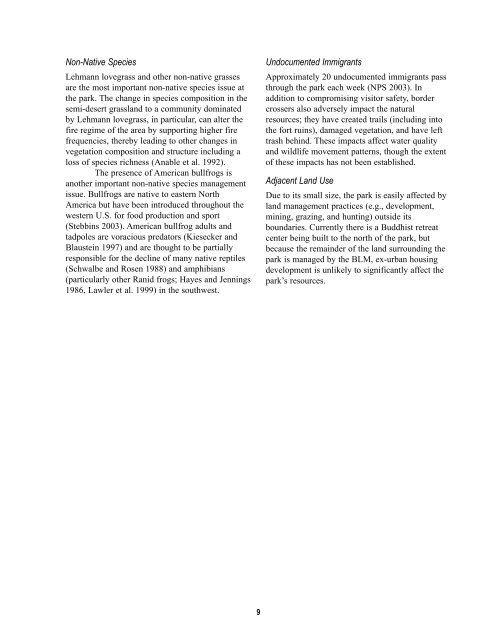Download this report as a 94-page PDF - USGS
Download this report as a 94-page PDF - USGS
Download this report as a 94-page PDF - USGS
You also want an ePaper? Increase the reach of your titles
YUMPU automatically turns print PDFs into web optimized ePapers that Google loves.
Non-Native Species<br />
Lehmann lovegr<strong>as</strong>s and other non-native gr<strong>as</strong>ses<br />
are the most important non-native species issue at<br />
the park. The change in species composition in the<br />
semi-desert gr<strong>as</strong>sland to a community dominated<br />
by Lehmann lovegr<strong>as</strong>s, in particular, can alter the<br />
fire regime of the area by supporting higher fire<br />
frequencies, thereby leading to other changes in<br />
vegetation composition and structure including a<br />
loss of species richness (Anable et al. 1992).<br />
The presence of American bullfrogs is<br />
another important non-native species management<br />
issue. Bullfrogs are native to e<strong>as</strong>tern North<br />
America but have been introduced throughout the<br />
western U.S. for food production and sport<br />
(Stebbins 2003). American bullfrog adults and<br />
tadpoles are voracious predators (Kiesecker and<br />
Blaustein 1997) and are thought to be partially<br />
responsible for the decline of many native reptiles<br />
(Schwalbe and Rosen 1988) and amphibians<br />
(particularly other Ranid frogs; Hayes and Jennings<br />
1986, Lawler et al. 1999) in the southwest.<br />
9<br />
Undocumented Immigrants<br />
Approximately 20 undocumented immigrants p<strong>as</strong>s<br />
through the park each week (NPS 2003). In<br />
addition to compromising visitor safety, border<br />
crossers also adversely impact the natural<br />
resources; they have created trails (including into<br />
the fort ruins), damaged vegetation, and have left<br />
tr<strong>as</strong>h behind. These impacts affect water quality<br />
and wildlife movement patterns, though the extent<br />
of these impacts h<strong>as</strong> not been established.<br />
Adjacent Land Use<br />
Due to its small size, the park is e<strong>as</strong>ily affected by<br />
land management practices (e.g., development,<br />
mining, grazing, and hunting) outside its<br />
boundaries. Currently there is a Buddhist retreat<br />
center being built to the north of the park, but<br />
because the remainder of the land surrounding the<br />
park is managed by the BLM, ex-urban housing<br />
development is unlikely to significantly affect the<br />
park’s resources.

















